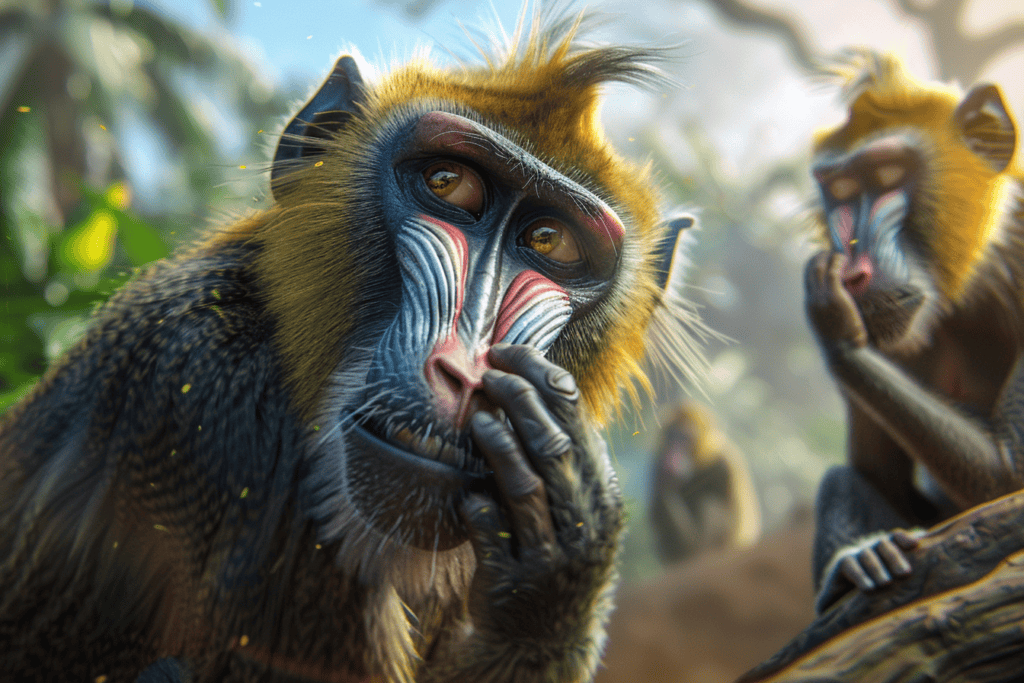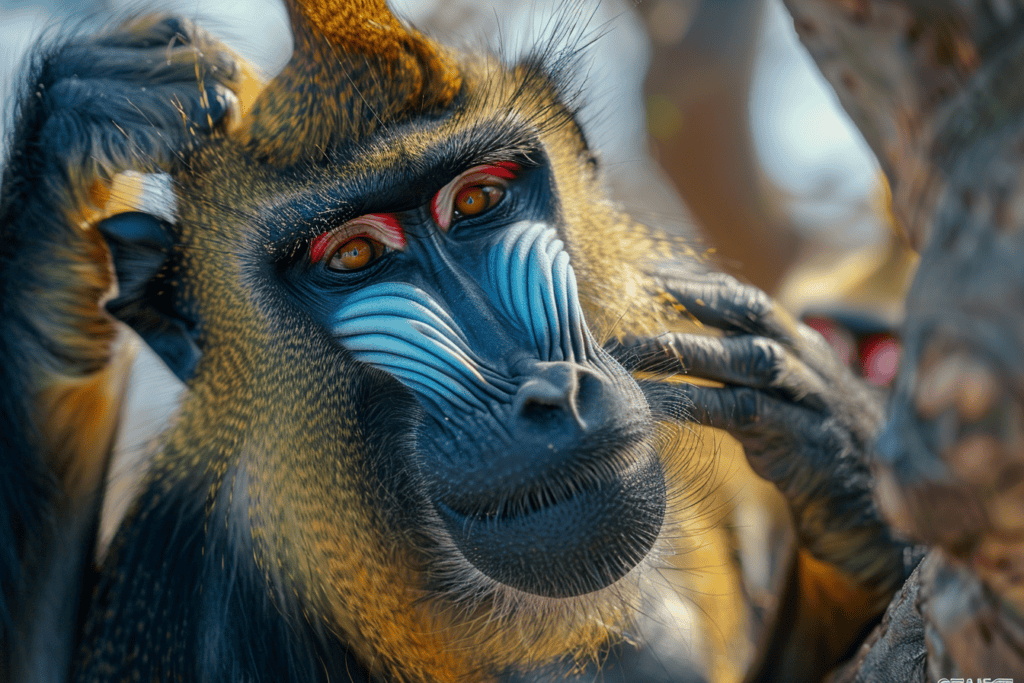Mandrills are the most colorful primates in the world, with vibrant hues that make them stand out from other mammals.
Their colorful faces and bodies are a sight to behold, and many people wonder why they are so colorful. The answer lies in their biology and social structure, which is fascinating to explore.

These primates are native to the rainforests of Central and West Africa, where they live in large social groups called hordes.
Within the group, there is a dominant male who leads the others, and females exercise selective breeding preferences when choosing their mates. As a result, males strive to maintain their status within the hierarchy.
A fading of their vibrant hues occurs if their status declines, potentially impacting their reproductive success.
Mandrills are not only the most colorful primates, but they are also one of the most colorful mammals in the world.
Their resplendent colors, according to Charles Darwin, rank with those of the most brilliant birds. Their vibrant hues serve a purpose in their social structure and biology, making them an intriguing subject to study. In this article, we will explore the fascinating purpose behind their colorful faces and bodies, and delve into the science behind their unique biology.
The Rainbow of the Rainforest
Mandrills have a unique coloration that is most prominent in males. The dominant males have bright colors on their faces, while the females and subordinate males have less vivid hues. The colors range from deep blues and purples to bright reds and pinks.
The colors on a mandrill’s face are not randomly distributed. The ridges above their eyes are blue, while their nose and upper lip are red. The cheeks are a bright shade of pink, and the rest of the face is a dark shade of blue.
Mandrill’s Palette: From Noses to Tails
The coloration of mandrills extends beyond their faces. Their rumps are a bright shade of blue, and their tails have a yellow tip. The rest of their body is covered in fur that ranges from brown to gray.
The bright colors on a mandrill’s body serve as a signal of their social status. The more dominant males have brighter colors, which attract females and intimidate other males. The colors also serve as a form of communication within the group.
By understanding the purpose behind their vibrant hues, we can appreciate these incredible creatures even more.
Fun Fact: The scientific name for the mandrill is Mandrillus sphinx.
Social Butterflies of the Animal Kingdom

Mandrills are social creatures that live in large groups consisting of both males and females. The social structure of mandrills is complex, and it is based on a hierarchy that determines the status of each individual in the group.
The hierarchy is established through aggressive interactions among the members of the group, and it is maintained through a combination of threat displays and physical violence.
Hierarchy and Color: The Link Between Status and Appearance
The dominant male, also known as the alpha male, is at the top of the hierarchy. He is the most powerful and influential member of the group, and he has the first choice of food and mates.
The other males in the group are ranked below him, and their status is determined by their ability to challenge and defeat other males.
One of the most fascinating aspects of mandrills is their colorful appearance. The bright colors of their faces and rumps are not just for show.
They are actually a visual signal of the mandrill’s status within the group. The more dominant a mandrill is, the brighter and more vivid its colors will be. This is because the bright colors are an indication of the mandrill’s genetic fitness, and they attract mates and intimidate rivals.
Communication Through Color: Signals Among Mandrills
Mandrills also use their colorful appearance to communicate with each other. They have a wide range of facial expressions and gestures that they use to convey different messages. For example, a mandrill will bare its teeth and stare directly at another mandrill as a sign of aggression. It will also raise its eyebrows and wrinkle its nose to show fear or submission.
In addition to facial expressions, mandrills also use their colors to communicate. For example, a mandrill will flash the bright colors of its rump as a warning signal to other members of the group. This signal tells the other mandrills that the flashing mandrill is upset or agitated, and that they should be cautious.
Survival in Vivid Detail

Mandrills, with their vibrant hues, may seem like easy targets for predators in the dense rainforest. However, their colors serve a crucial purpose in their survival.
The bright blue and red on their faces and backsides act as a form of camouflage, making it difficult for predators such as leopards to spot them among the foliage.
Moreover, the dominant male’s bright colors serve as a warning to other males, indicating his strength and dominance over the group. This helps prevent conflicts and fights, which could lead to injuries or death.
Feeding the Colorful Life: Mandrill Diet and Foraging
Mandrills are omnivores, which means they eat both plants and animals. Their diet primarily consists of fruits, insects, leaves, and roots. They spend most of their day foraging for food in the dense rainforest, using their keen sense of smell to locate ripe fruit and their strong jaws to crack open nuts and seeds.
Interestingly, mandrills have been known to eat toxic plants, which contain chemicals that are harmful to most animals. However, mandrills have evolved to detoxify these chemicals, allowing them to eat a wider variety of plants than other primates.
Conservation: Securing a Future for the World’s Most Colorful Primates

Mandrills are fascinating creatures with their vibrant hues and unique patterns. However, they are also vulnerable to habitat loss and hunting, which poses a significant threat to their survival. The International Union for Conservation of Nature (IUCN) lists mandrills as vulnerable, with their population decreasing due to habitat loss and hunting.
Mandrills are native to the rainforests of Africa, specifically in Gabon, Cameroon, Congo, and Equatorial Guinea. Unfortunately, the rainforests in these regions are rapidly disappearing due to deforestation, mining, and agriculture. As a result, mandrills are losing their natural habitat, and their populations are declining.
Conservation efforts are crucial to securing a future for mandrills. Several organizations are working to protect mandrills and their natural habitat. For example, the Wildlife Conservation Society (WCS) is working with local communities in Gabon to conserve the rainforests and protect mandrills from hunting.
Moreover, the WCS is also working to educate people about the importance of conservation and the role that mandrills play in maintaining the ecosystem. By raising awareness about the threats facing mandrills, the WCS hopes to inspire people to take action to protect these fascinating primates.
In addition to conservation efforts, scientific research is also crucial to understanding mandrills and their behavior. By studying mandrills in their natural habitat, scientists can learn more about their social structure, communication, and other aspects of their behavior. This knowledge can help inform conservation efforts and ensure that they are effective in protecting mandrills and their natural habitat.
Frequently Asked Questions
What purpose do the vibrant colors of a mandrill serve in the wild?
The mandrill’s vibrant colors serve multiple purposes in the wild. One of the primary purposes is to communicate social status and dominance within their group. The brighter and more colorful the mandrill’s face and rump, the more dominant they are within the group. These colors also help mandrills identify each other and locate their group members in the dense rainforest. Additionally, the colors may serve as a warning to potential predators, indicating that the mandrill is not an easy target.
How does the mandrill’s colorful appearance affect its social interactions?
The mandrill’s colorful appearance plays a significant role in their social interactions. As mentioned earlier, the brighter and more colorful the mandrill’s face and rump, the more dominant they are within their group. Dominant males are more likely to mate with females and have access to better food sources. In contrast, less colorful males may have a lower social status and may not have access to the same resources. Mandrills also use their colorful faces and rumps to communicate with each other, displaying different colors to indicate aggression, submission, or interest.
What are the main threats to mandrills in their natural habitat?
Mandrills face several threats in their natural habitat, including habitat loss due to deforestation, hunting for bushmeat, and the illegal wildlife trade. As their habitat continues to shrink, mandrills are forced to compete for resources with other animals, leading to increased conflict and potential extinction.
How do the unique features of mandrills benefit them in their ecosystem?
Mandrills have several unique features that benefit them in their ecosystem. Their powerful jaws and teeth allow them to eat tough vegetation and fruits that other primates cannot. Their ability to climb trees and move quickly on the ground helps them evade predators and locate food sources. Additionally, their colorful appearance allows them to communicate with each other and locate their group members in the dense rainforest.
Can the coloration of a mandrill indicate its health or status within the group?
Yes, the coloration of a mandrill can indicate its health or status within the group. Brighter and more colorful mandrills are typically healthier and have a higher social status within their group. In contrast, less colorful mandrills may be sick or have a lower social status.
What adaptations help mandrills survive alongside their predators?
Mandrills have several adaptations that help them survive alongside their predators. Their powerful jaws and teeth allow them to defend themselves against predators.
Meanwhile, their ability to climb trees and move quickly on the ground helps them evade predators. Additionally, their colorful appearance may serve as a warning to potential predators, indicating that the mandrill is not an easy target.









